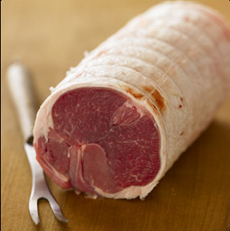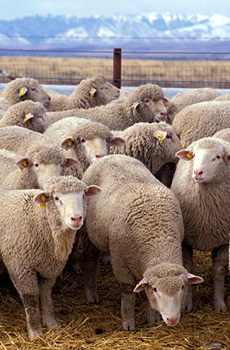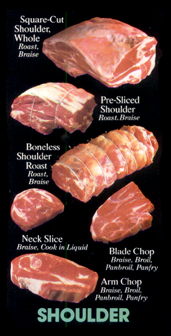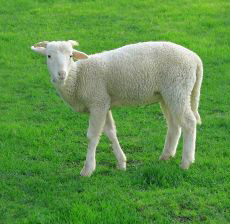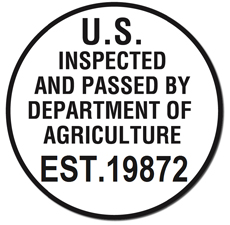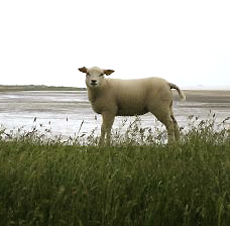Lamb: It’s Not Just A Spring Dish While the term “spring lamb” leads some people to think of lamb as a seasonal food, it is now available year round (see the definition of spring lamb). Since ancient times, lamb has been a religious and sacrificial symbol. It is the traditional main dish at Easter dinner, commemorating the Last Supper (at which the meat served was likely lamb). Enjoy more lamb—chops, roasts, kebabs, lamburgers, braised, in stews and in a wide variety of international dishes. While lamb chops can be costly, other cuts are competitive in price. After you’ve browsed through our Lamb Glossary, you can find dozens of lamb recipes. Also see our our Beef Glossary and Pork Glossary. If you love to learn about food in general, we have Food Glossaries for just about every category of food, that are informative and fun to read. But first, gain a better understanding below, of the many cuts of lamb available to you, and how to cook them. Click on the letter of the alphabet in this bar to get to a term without having a b c d e f g h i j k l m n o p q r s t u v w x y z
This glossary is protected by copyright and cannot be reproduced in whole
Chart of lamb cuts courtesy of the American Lamb Board Lamb is aged to develop additional tenderness and flavor. Usually only ribs and loins of high-quality lamb are aged, and these products are mainly sold to restaurants. Aging is done commercially under controlled temperatures and humidity, for 10 days to 6 weeks. Lamb that is slaughtered when it is between six and eight weeks old. A leg or shoulder roast that is completely boned, with the internal fat removed and the excessive outer fat trimmed off. Properly rolled, it will be cylindrical in shape and ideal for a rotisserie or as an oven roast. You can see a photo of a boneless shoulder cut roast below in the Shoulder Cuts chart. A boneless roast cut from the leg.
The leg, completely boned and removed of all excess fat. When spread flat on the cooking surface, it resembles a butterfly. Popular for broiling or outdoor grilling, it provides a natural range of “doneness,” since the thickest portion will be rare, the middle medium and the thinnest portions well done.
There are five basic major (primal) cuts of lamb: leg, loin, shoulder, rack and shank/breast.* Food markets further label the product directionally, e.g., “shoulder roast,” “boneless breast” and “loin chop.” *This is the fore shank of the lamb. There is also a hind shank on the leg.
A method that produces an excellent roast, although it results in more shrinkage, oven splattering, and sometimes smoke and excessive cooking odors. Preheat the oven to 450°F and roast for 15 to 20 minutes to brown, then reduce heat to 325°F and continue roasting to the desired degree of internal doneness (see Cooking Time, above).
The protein, vitamin and mineral content of lamb are similar in all grades. Ungraded lamb does not indicate that the lamb is either higher or lower in quality than graded lamb, and all lamb sold in the U.S. has been government inspected for wholesomeness (i.e., it is disease-free). Ground or cubed lamb made be made from any cut. Cubes are used for stew; cubed steaks and lamb patties can be broiled or panfried; ground lamb can be cooked in any variety of ways, from burgers to moussaka and in other famous (and not-so-famous) dishes. See the different cuts in the chart at the right. The rear legs and hip portion of the lamb. It includes the sirloin, leg and hind shank. A young lamb that has been entirely milk-fed (i.e., not pastured). It is known for its tenderness and delicate flavor. It is generally roasted whole. HORMONES, ANTIBIOTICS & ADDITIVES Hormones. Zeronal, a synthetic hormone, may be used to promote efficient growth in feedlot lambs (the feedlot stage is the final stage before slaughter). The hormone is implanted on the lamb’s ear and is time-released for about 30 days. A withholding period when no hormones are given is required for at least 40 days before slaughter. Antibiotics. Antibiotics may be given to prevent or treat disease in lambs. A recommended withholding period is required from the time antibiotics are administered until it is legal to slaughter the animal, so residues can exit the animal’s system. Random samples from the Food and Drug Administration’s monitoring program have shown a very low percentage of residue violations. (Choice-grade lamb is available at retail that is raised without antibiotics and growth hormones.) Additives. Additives such as MSG, salt or sodium erythorbate are not allowed to be used on fresh lamb. If they are used on processed lamb, they must be listed on the label. Chart of lamb cuts in black boxes are courtesy of American Lamb Board. A double French rack. Two or more rib sections are joined and tied, and the legs are Frenched. The center is usually filled with stuffing before roasting. See the French Rack, also called the rib roast, in the Rib Cuts chart. Two racks tied together are a crown roast. The meat of a sheep that is less than one year old. Meat from an older sheep is called mutton. Most lambs are brought to market when they are between six and eight months. Typically, lambs graze on pasture and different types of grain and are “finished” (grown to maturity) in feedlots, where they receive specially-formulated feed. A mature lamb weighs about 120 pounds and yields approximately 42 pounds of saleable meat. Lamb chops are cut from the shoulder, rib, loin and sirloin area. Loin chops and rib chops are the most tender. The less expensive shoulder chops (called blade and arm chops) and sirloin chops from the leg can be just as tender, but they are not as visually attractive because the meat is separated by bands of connective tissue. Chops are usually served broiled, panfried or grilled. Lamb steaks are cut from the leg. They are a way to enjoy “leg of lamb” when there aren’t enough people to eat a leg. They can be marinated and then raised, broiled, grilled or sautéed. They are easy to pan-fry pan in olive oil, seasoned with thyme, 2 minutes a side. Sprinkle salt and pepper after cooking; deglaze the pan with white wine and more herbs. The leg of lamb produces a leg center slice (steak) for broiling, grilling, panbroiling or panfrying and a variety of of roasts: American-style leg, boneless leg (rolled), center leg, combination leg, French-style leg, French-style leg/sirloin off, shank half of leg and sirloin half of leg. See the different cuts in the chart at the right. The leg of lamb can be the whole leg including the sirloin, or the short cut leg, sirloin of. It is usually roasted, though it can be broiled, grilled and barbecued as well. Some find the rear of the lamb has bolder flavor, but retains the same juicy tenderness as the rib and loin portions.
The meat from an unweaned lamb four to six weeks old. It is largely unavailable in the U.S. but more common in northern Spain. Milk-fed lamb meat is considered finer than older lamb. See also Baby Lamb. The meat of a sheep older than one year. Mutton is often less tender than lamb, with a stronger flavor. In many eastern countries such as India and Pakistan, mutton refers to goat meat, not sheep meat. Products labeled “natural” cannot contain any artificial flavoring, coloring, chemical preservative or other artificial or synthetic ingredient. The product and its ingredients cannot be more than minimally processed (ground meat, for example). All products claiming to be natural should be accompanied by a brief statement which explains what is meant by the term “natural.”
The square-cut shoulder contains four or five ribs. Two one-inch-thick, round bone chops are removed. The shoulder is then sliced (blade bone side) into three-quarter-inch chops, put together and tied with two strings. You can see a photo in the chart of Shoulder Cuts.
RaM An adult male sheep. RED MEAT Oxygen is delivered to muscles by the red blood cells. One of the proteins in RIB CUTS The rib area lies between the shoulder and the loin. Cuts include rib chops and Frenched rib chops, which are broiled, grilled, panbroiled or panfried; the rack of lamb (or rib roast) and the crown roast.
The shoulder of the lamb is less expensive than the rib, loin or leg. While the meat is well-marbled and full-flavored, there is more connective tissue. The shoulder yields the following cuts: cubes for kabobs; blade chips, boneless blade chops (Saratoga chops) and arm chops, which can be broiled, panbroiled and panfried; and the boneless shoulder, cushion shoulder and square shoulder roasts. There is also meat for stewing. See the cuts in the chart at the right. Sirloin CUTS The sirloin is the section between the back of the loin and the hipbone. Cuts include sirloin chops, which are broiled, panbroiled or panfried; the sirloin roast and the boneless sirloin roast (shown in the photo at right, trimmed of excess fat). The boinless sirlon is the equivalent of the beef tenderloin, tender and flavorful.
Try the following wine pairings with lamb:
Lifestyle Direct, Inc. All rights reserved. Images are the property of their respective owners.
|

The Nibble Blog
The Latest Products, Recipes & Trends In Specialty Foods
The gourmet guide you’ve been waiting for. New food adventures are served up daily. Check it out!

Food Glossary
Our Food Directories Are "Crash Courses" In Tasty Topics
Your ultimate food lover’s dictionary packed full of information and historical references. Take a look!
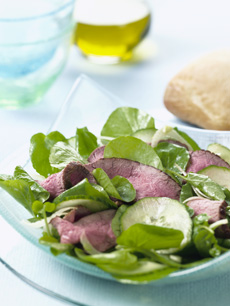
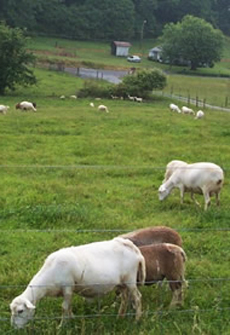
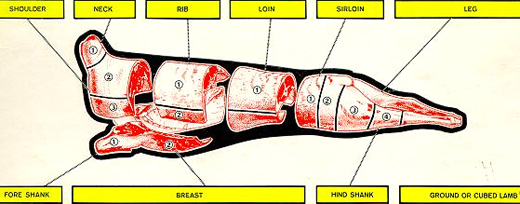
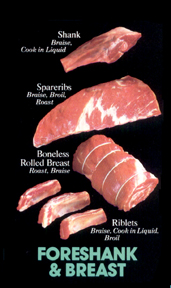
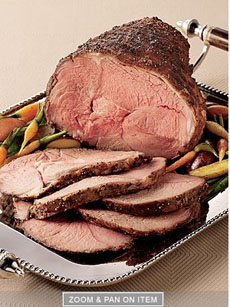
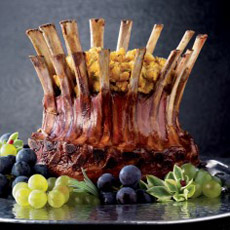
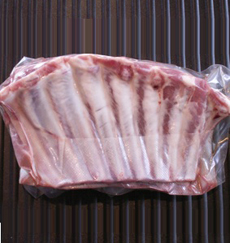
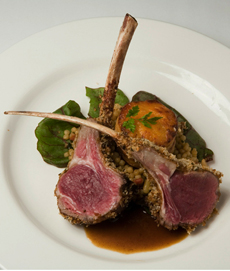
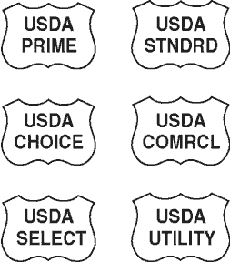
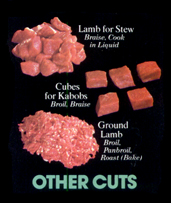
 INTERLACED ROAST
INTERLACED ROAST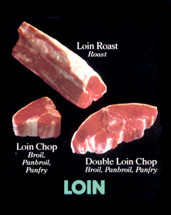
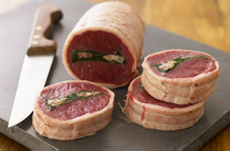
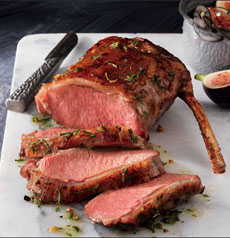
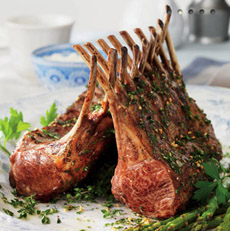
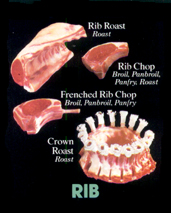 meat, myoglobin, holds the oxygen in the muscle. The amount of myoglobin in animal muscles determines the color of meat. Lamb is red because it contains more myoglobin than chicken or fish. The other red meats are beef, pork and veal.
meat, myoglobin, holds the oxygen in the muscle. The amount of myoglobin in animal muscles determines the color of meat. Lamb is red because it contains more myoglobin than chicken or fish. The other red meats are beef, pork and veal. 